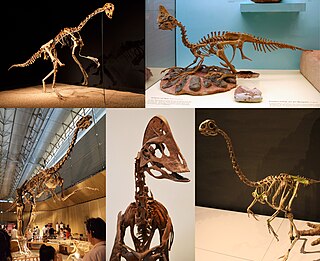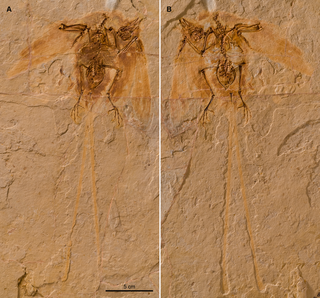
Deinonychosauria is a clade of paravian dinosaurs which lived from the Late Jurassic to the Late Cretaceous periods. Fossils have been found across the globe in North America, Europe, Africa, Asia, South America, and Antarctica, with fossilized teeth giving credence to the possibility that they inhabited Australia as well. This group of dinosaurs are known for their sickle-shaped toe claws and features in the shoulder bones.

Caudipteryx is a genus of small oviraptorosaur dinosaurs that lived in Asia during the Early Cretaceous, around 124.6 million years ago. They were feathered and extremely birdlike in their overall appearance, to the point that some paleontologists suggested it was a bird. Two species have been described: C. zoui, in 1998, and C. dongi, in 2000.

Maniraptora is a clade of coelurosaurian dinosaurs which includes the birds and the non-avian dinosaurs that were more closely related to them than to Ornithomimus velox. It contains the major subgroups Avialae, Dromaeosauridae, Troodontidae, Oviraptorosauria, and Therizinosauria. Ornitholestes and the Alvarezsauroidea are also often included. Together with the next closest sister group, the Ornithomimosauria, Maniraptora comprises the more inclusive clade Maniraptoriformes. Maniraptorans first appear in the fossil record during the Jurassic Period, and survive today as living birds.

The Enantiornithes, also known as enantiornithines or enantiornitheans in literature, are a group of extinct avialans, the most abundant and diverse group known from the Mesozoic era. Almost all retained teeth and clawed fingers on each wing, but otherwise looked much like modern birds externally. Over eighty species of Enantiornithes have been named, but some names represent only single bones, so it is likely that not all are valid. The Enantiornithes became extinct at the Cretaceous–Paleogene boundary, along with Hesperornithes and all other non-avian dinosaurs.

Oviraptorosaurs are a group of feathered maniraptoran dinosaurs from the Cretaceous Period of what are now Asia and North America. They are distinct for their characteristically short, beaked, parrot-like skulls, with or without bony crests atop the head. They ranged in size from Caudipteryx, which was the size of a turkey, to the 8-meter-long, 1.4-ton Gigantoraptor. The group is close to the ancestry of birds. Some researchers such as Maryanska et al (2002) and Osmólska et al. (2004) have proposed that they may represent primitive flightless birds. The most complete oviraptorosaur specimens have been found in Asia. The North American oviraptorosaur record is sparse.

Scansoriopterygidae is an extinct family of climbing and gliding maniraptoran dinosaurs. Scansoriopterygids are known from five well-preserved fossils, representing four species, unearthed in the Tiaojishan Formation fossil beds of Liaoning and Hebei, China.

Jeholornis is a genus of avialan dinosaurs that lived between approximately 122 and 120 million years ago during the early Cretaceous Period in China. Fossil Jeholornis were first discovered in the Jiufotang Formation in Hebei Province, China and additional specimens have been found in the older Yixian Formation.

Jixiangornis is a genus of basal avialan dinosaurs from the Early Cretaceous. Like later avialans, it had no teeth, but it also had a long tail, unlike modern birds. Since teeth were still present in some more derived short-tailed avialans, Jixiangornis seems to have evolved its toothlessness independently of modern birds. The long forelimb indicates at least some aerial ability. Jixiangornis is currently known only from a single specimen, a complete but juvenile skeleton. The fossil was found in the Yixian Formation near Beipiao City, western Liaoning, China.

Graciliraptor is a genus of theropod dinosaur from the early Cretaceous Period. It is a microraptorine dromaeosaurid.

Yandangornis is a genus of theropods from the Late Cretaceous Tangshang Formation of China. It lived 81.5 million years ago in what is now China. The type species, Y. longicaudus, was formally described by Cai and Zhou in 1999.

Avialae is a clade containing the only living dinosaurs, the birds, and their closest relatives. It is usually defined as all theropod dinosaurs more closely related to birds (Aves) than to deinonychosaurs, though alternative definitions are occasionally used.
Sauriurae is a now-deprecated subclass of birds created by Ernst Haeckel in 1866. It was intended to include Archaeopteryx and distinguish it from all other birds then known, which he grouped in the sister-group Ornithurae. The distinction Haeckel referred to in this name is that Archaeopteryx possesses a long, reptile-like tail, while all other birds known to him had short tails with few vertebrae, fused at the end into a pygostyle. The unit was not much referred to, and when Hans Friedrich Gadow in 1893 erected Archaeornithes for basically the same fossils, this became the common name for the early reptile-like grade of birds.

Ornithothoraces is a group of avialan dinosaurs that includes all enantiornithes and the euornithes, which includes modern birds and their closest ancestors. The name Ornithothoraces means "bird thoraxes". This refers to the modern, highly advanced anatomy of the thorax that gave the ornithothoracines superior flight capability compared with more primitive avialans. This anatomy includes a large, keeled breastbone, elongated coracoids and a modified glenoid joint in the shoulder, and a semi-rigid rib cage. In spite of this at least the sternum seems to have developed convergently rather than being a true homology.

Pygostylia is a group of avialans which includes the Confuciusornithidae and all of the more advanced species, the Ornithothoraces.
Zhongornis is a genus of primitive maniraptoran dinosaurs that lived during the Early Cretaceous. It was found in rocks of the Yixian Formation in Lingyuan City (China), and described by Gao et al. in 2008.

Euornithes is a natural group which includes the most recent common ancestor of all avialans closer to modern birds than to Sinornis.

Aurornis is an extinct genus of anchiornithid theropod dinosaurs from the Jurassic period of China. The genus Aurornis contains a single known species, Aurornis xui. Aurornis xui may be the most basal ("primitive") avialan dinosaur known to date, and it is one of the earliest avialans found to date. The fossil evidence for the animal pre-dates that of Archaeopteryx lithographica, often considered the earliest bird species, by about 10 million years.

Anchiornithidae is a family of small paravian dinosaurs. Anchiornithids have been classified at varying positions in the paravian tree, with some scientists classifying them as a distinct family, a basal subfamily of Troodontidae, members of Archaeopterygidae, or an assemblage of dinosaurs that are an evolutionary grade within Avialae or Paraves.

Jinguofortis is a genus of primitive avialan belonging to the clade Pygostylia that lived during the Valanginian stage of the Early Cretaceous. It was found in the Dabeigou Formation in northeastern China, and isotope dating from the samples overlying the bird-bearing horizon is 127 million years ago.
Kompsornis is an extinct genus of avialan dinosaurs that lived during the Early Cretaceous period of China. The type and only known species is Kompsornis longicaudus; the specific name means "long-tailed". It is known from only a single fossil specimen from the Jiufotang Formation. Kompsornis was closely related to the well-known Jeholornis, another long-tailed avialan from China, but differs from it in features of its skeleton, particularly the fusion and growth rate of its bones. Like other jeholornithiforms, Kompsornis was a long-tailed avialan with long wings and possessed little or no teeth, with none identified in the single specimen of Kompsornis.




























